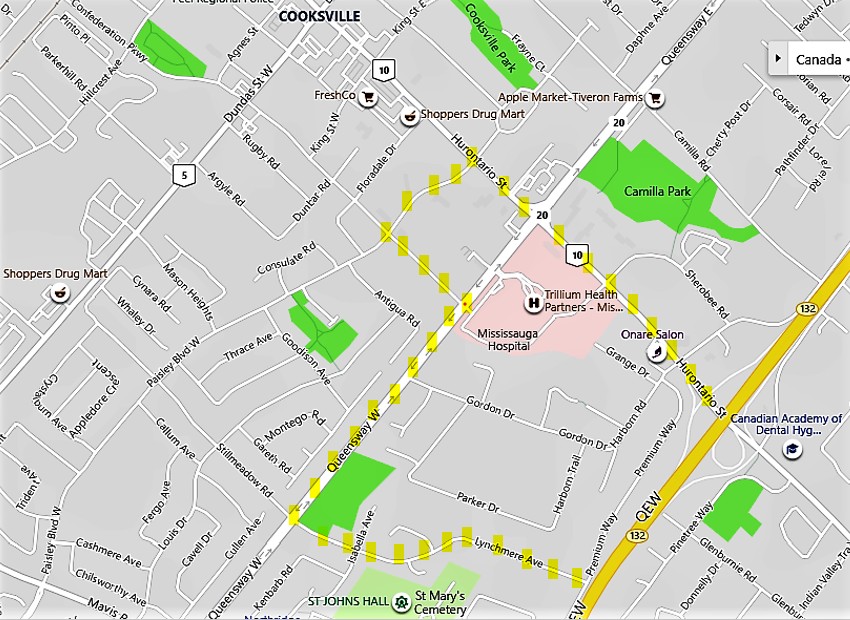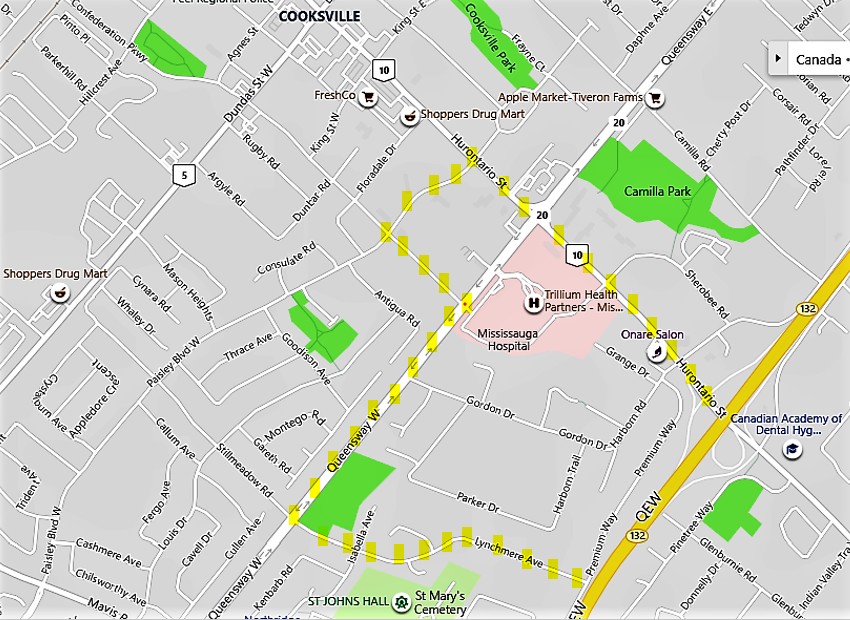
This Mississauga neighbourhood has the highest rate of COVID-19 in Peel and it’s not even close
(Clarification: An earlier version of this story failed to account for the presence of Camilla Care long-term care home and its impact on the rate of COVID-19 infection in this neighbourhood. The story has been updated to account for this data. The Pointer regrets the omission.)
From the beginning of the pandemic till August 8, the overall rate of COVID-19 in Peel Region was 515 per 100,000 residents. In one Mississauga neighbourhood in the Cooksville area, the rate was 7,145 per 100,000.
This is by far the worst hit place in the entire region.
Why?
The neighbourhood is bordered by Hurontario Street to the east, Stillmeadow Road, Lynchmere Avenue and Confederation Parkway on the western edge, the QEW on the south and Queensway West and Paisley Boulevard West along its northern boundary.

The Mississauga neighbourhood in Cooksville with by far the highest rate of COVID-19 cases in Peel
It includes Mississauga Hospital, and the Camilla Care Community long-term care home, located near its northeast corner, which both play significant roles in the alarmingly high rate of COVID-19 cases within the neighbourhood. But other demographic characteristics also play a role in the sky-high rate, and help shed light on the infection trends in other local neighbourhoods.
So what are the demographics of this particular area?
According to the 2016 Census, the neighbourhood had 3,527 residents, and from the beginning of the pandemic to August 8, it had 252 COVID-19 cases. By comparison, a nearby neighbourhood in the Lorne Park area of the city, one of the most affluent parts of the GTA, had just five cases over the same period, despite a population that is considerably higher, with 4,688 residents as of 2016.
But while that neighbourhood had a median total individual income of $110,898 in 2016, the Cooksville subdivision, just to the east and on the other side of the QEW, had a median total individual income of $28,672.
The housing in this subdivision neighbourhood, which runs right along Hurontario Street, is vastly different, as well.
As of the 2016 Census, there were 3,307 residents per square kilometre, compared to the overall GTA figure of 1,003 people per square kilometre, so it is three times more dense than the overall living conditions in the Toronto Census Metropolitan Area.
The housing characteristics could have the most significant impact on the dramatically higher COVID-19 rate in the neighbourhood. While the same Lorne Park Census tract mentioned above had a total of 1,460 private dwellings and 1,440 of those were single-detached family houses, with only 5 apartments, the Cooksville neighbourhood is almost the opposite. It had, as of the 2016 Census, 250 single-detached family houses, and 885 apartments.
The area also includes the Camilla Care Community long-term care home, which has been particularly hard hit by COVID-19. In two separate outbreaks, the home has seen a total of 242 cases among residents and staff — the vast majority of the cases in the area — and 67 residents passed away. Excluding the cases of COVID-19 among residents at Camilla Care, the infection figures in the Cooksville neighbourhood would still be approximately 14 times higher than the Lorne Park neighbourhood, which could be explained by demographics in the area.
Perhaps the most glaring difference between the Lorne Park neighbourhood with one of Peel’s lowest COVID case rates and the Cooksville neighbourhood with Peel’s highest case rate, is the racial composition of the two areas, which are only about one kilometre apart, separated by the Credit River.
About 20 percent of the Lorne Park subdivision residents were visible minorities, as of 2016, while just over 60 percent of the Cooksville subdivision residents, most of whom lived in apartments, were visible minorities.
The Region of Peel’s data shows that visible minorities are overwhelmingly overrepresented among the population that has tested positive for COVID-19, while the white population is significantly underrepresented.
As the pandemic continues, it will be crucial for public health officials, school boards and politicians to focus resources on the areas in Peel that need help the most.
Email: [email protected]
Twitter: @JoeljWittnebel
COVID-19 is impacting all Canadians. At a time when vital public information is needed by everyone, The Pointer has taken down our paywall on all stories relating to the pandemic and those of public interest to ensure every resident of Brampton and Mississauga has access to the facts. For those who are able, we encourage you to consider a subscription. This will help us report on important public interest issues the community needs to know about now more than ever. You can register for a 30-day free trial HERE. Thereafter, The Pointer will charge $10 a month and you can cancel any time right on the website. Thank you.
Submit a correction about this story


